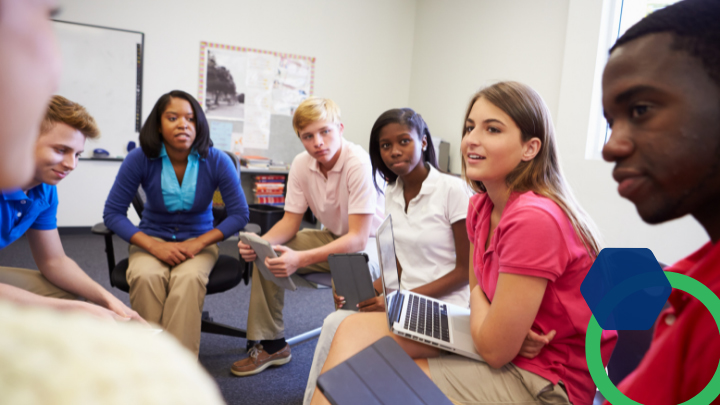In comparison to the years spent gaining teacher certification, and the process of classroom observation and evaluation, creating a recording of a lesson in order to grow your teaching is quick, relatively easy— and it works!
I ask most of the teachers I coach to video record at least one lesson. There is a list of reasons why I ask but suffice to say that a video tells me so much about the teaching and learning, so it increases my efficiency. Ryan Humphrey, a middle school science teacher in Livonia, New York, decided to try it and he did it with no planning or prep involved beyond acquiring the recording device. Here’s Ryan’s story:
Cheryl: It sounds like you just dove in and tried videotaping your own lesson. Many teachers are a bit frightened of doing this. Did you have any reservations? If not, could you explain the thinking behind your decision?
Ryan: I can’t say I really had any reservations or fear of videotaping myself as I find it much more comforting knowing that I can watch it by myself and be my own critic. The idea is for me to get a clear visual of things I can improve on, which will directly improve student learning. And to be honest, it’s more calming videotaping myself than having administrators in the room.
Cheryl: You mentioned that you had a planning period immediately after the class you recorded, so you watched it right away. Did you have a sense, from the start, of what part of the lesson you wanted to focus on? Or was your thinking wide open, and ready to see whatever came up?
Ryan: Immediately, as I began the pre-lab instruction, I was thinking about how I could switch it to more student based. The group I videotaped was a consultant group and there were many students absent the previous day. After watching the video, I noticed I was speaking for about 15 minutes before students even began the lab. I probably would not have talked for this long if I knew the students had a solid foundation of the material leading up to this lab. Thinking now, I may have pushed that lab off for a day and organized a small group review for students as their pre-lab.
Cheryl: You shared that there were immediate changes you made, that you felt you spent too long getting to the lab activity and that as you went on teaching that lab the remainder of the day you made this change. Did this shift require a lot of planning on your part? Did you find yourself further refining it as the day went on?
Ryan: Immediate changes I made were just in the wording within the lab that allowed students to better understand the task. After completion of the lab that day, I definitely would use some different materials. They were asked to create a sediment bottle and then justify how the sediments settled within the bottle. I tried the lab myself the previous day and the results looked promising but using only 2-3 sediments types instead of 4-5 would give clearer results. Students grasped the concept that particles settle larger to smaller but not all the bottles turned out like they should.
Cheryl: What told you that the run-up to the lab was too long, was it the student response or your sense from now being a participant (as a viewer)?
Ryan: The obvious reason was that the students were starting to get squirmy. Trying to make sure the entire group had a solid foundation was important. A student led review would make for a better engagement piece.
Cheryl: Sounds like you found recording your lesson exciting and worthwhile, and are going to continue. Would you have any suggestions for someone who wants to try this strategy?
Ryan: Really the only issue I saw with the SWIVL device is trying to get clear camera footage and audio. Try to find the perfect spot in the room that will allow the entire class to be seen. The flaw of the SWIVL is that it follows the person who has the beacon (the teacher usually). I attempted getting audio from each group, but I couldn’t get the multiple audio devices to sync up. There would have been a recording of some great student interaction and collaboration if those individual recording devices would have worked. Honestly, the SWIVL is great, I just need more time to use it and become efficient using it.
For Ryan, and teachers at a few of the districts that I work with, recording their teaching has been made much easier with the purchase of a device called a SWIVL. If you don’t have this device, it is still reasonably possible to record your classroom. Along with some suggestions for how, this blog gives important tips to make the end product successful.
Questions to ask yourself to prepare for a successful classroom recording session
If you’d like to record the entire class period, ask a colleague to use an iPad* or camera.
It is important that they move around the room in order to capture audio that can be heard. By moving closer to the students, and moving around the room, the video will provide useful audio.
Do you need the entire class period?
Small snippets can be very insightful. Pick the times and actions you want to reflect on, and use the same approach as above.
Do you need to see yourself teaching?
At times, what you really want to know is what the students are doing or thinking.
While students are working and discussing, they can make the recording using their cellphones*, iPads*, Chromebooks, etc. One math teacher I coach this year tried this as a strategy to up the rigor of math talk. Not only did it make an appreciable difference, students really liked doing it.
An alternative to students doing the recording is for you to carry the device (pockets!). As you circulate, holding thedevice closer to the students than to you is the only way you will capture student audio.
To make recording less stressful for students, point the device at their work, not at their faces, and keep your voice softer than theirs.
This is a great way to check how rigorous your questioning is. To see great examples, check out the videos made by Michelle Marcus in this lesson from our Master Teacher Project. Another alternative is to set up a quieter place where students step in front of the camera and make a recording in response to your prompts. Master Teacher Mariana Garcia used her storage space to do this.
Here’s some tips to get started:
- Start small— just video a small piece of a lesson using a device that you already own.
- Tell students that you are doing this to improve your teaching. Don’t plan a special lesson— pick a random day.
- Also, advise your school administrator beforehand what you are doing and why; some students are bound to go home and tell family members that you were recording.
As I do with all of the teachers I coach, I urge you to try this strategy. We’d love to hear your story of how you use video to reflect on, and improve, your teaching.
*If you are using a cell phone or iPad to record video, hold the device horizontally.








